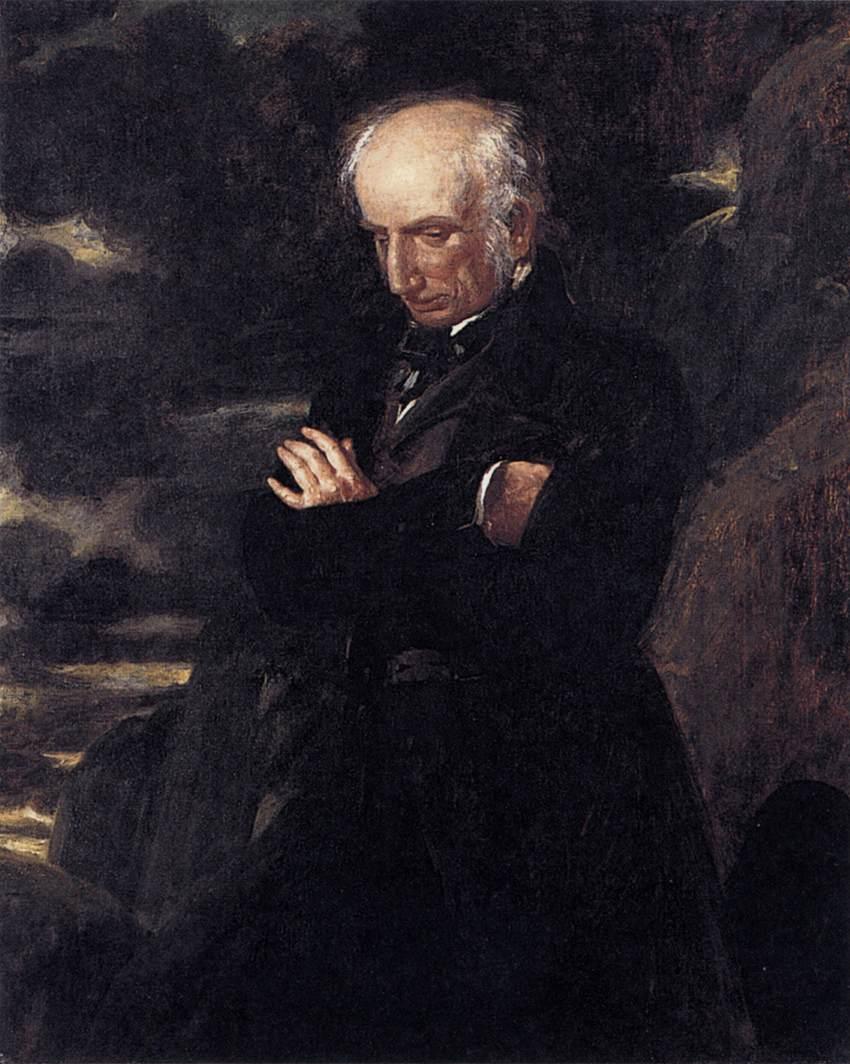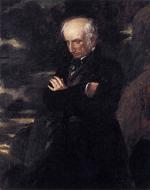Created by Christopher Rovee on Fri, 06/22/2018 - 09:23
Description:
A monument to the mind-in-creation, Benjamin Robert Haydon’s Wordsworth on Helvellyn (1842) is one of Romanticism’s iconic images. It gives concrete form to the romantic critic William Hazlitt’s description of a William Wordsworth who “lives in the busy solitude of his own heart; in the deep silence of thought” (19: 11). The twentieth-century art historian A. C. Sewter considered it not just the best portrait of Wordsworth, but “the finest portrait of the nineteenth century” (324). And in the words of the critic and biographer Stephen Gill, it is “what an image of Wordsworth should be” (38). Such comments extend the initial adoration within the Wordsworth circle. On her death-bed in 1847, the poet’s daughter, Dora, said of the portrait: “it is perfection” (qtd. in Blanshard 167).
The portrait by Haydon originated in an exchange of letters and artistic gifts. Having received from Haydon an etching of a grandly heroic, 9-by-11-foot portrait of the Duke of Wellington, Wordsworth (on 31 August 1840) produced an ekphrastic poem about this image while walking up Helvellyn. As he wrote Crabb Robinson:
Haydon has just sent me a spirited Etching of his Portrait of the Duke of Wellington taken 20 years after the Battle of Waterloo, from the Life. He is represented upon the field; but no more of the Picture—take my Sonnet which it suggested the other day. The lines were composed while I was climbing Helvellyn. … I was seven hours on my feet without being at all tired… (Letters 4: 106-7)
When Wordsworth sent Haydon this sonnet on 2 September, he noted that it was “actually composed while I was climbing Helvellyn last Monday” (Letters 4: 100-1). Wordsworth on Hevellyn thus can be understood as a portrait of Wordsworth composing a sonnet about another portrait by Haydon (see Hunt; Rovee 171-77).
Works Cited
Blanshard, Frances. Portraits of Wordsworth. Ithaca, NY: Cornell University Press, 1959.
Gill, Stephen. Wordsworth and the Victorians. Oxford: Clarendon Press, 1998.
Hazlitt, William. The Complete Works of William Hazlitt. Ed. P. P. Howe. 21 vols. London: J. M. Dent, 1934.
Hunt, Bishop C., Jr. “Wordsworth, Haydon, and the ‘Wellington’ Sonnet.” Princeton University Library Chronicle 36 (1975): 111-32.
Rovee, Christopher K. Imagining the Gallery: The Social Body of British Romanticism. Stanford, CA: Stanford University Press, 2006.
Sewter, A. C. “A Revaluation of Haydon,” Art Quarterly 5 (1942).
Wordsworth, William, and Dorothy Wordsworth. The Letters of William and Dorothy Wordsworth: The Later Years, 1821-1853. Ed. Ernest de Selincourt. 2nd ed. Rev. and arranged by Alan G. Hill. 4 parts. Oxford University Press, 1978-88.
How to Cite this Web Page
Rovee, Christopher. "Benjamin Robert Haydon, Wordsworth on Helvellyn (1842)." Omnibus Edition of "On a Portrait of Wordsworth." Eds. Dino Franco Felluga, Joshua King, Christopher Rovee and Marjorie Stone. The COVE: The Central Online Victorian Educator, covecollective.org. [Here, add your last date of access to The COVE].
Copyright:
Location:
Accession Number:
Height (in centimeters):
Width (in centimeters):
Associated Place(s)
Timeline of Events Associated with Benjamin Robert Haydon, Wordsworth on Helvellyn (1842)
Part of Group:
Artist:
- Benjamin Robert Haydon


